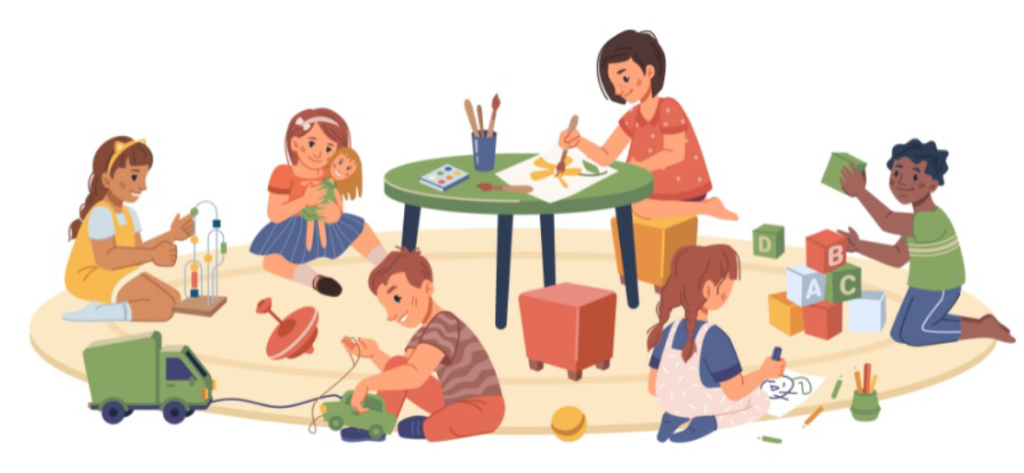Across schools in India, a recurring challenge has emerged: finding leaders who can prioritise child-centred edcation while managing the complex, multi-tasking demands of school leadership. Even more pressing is the struggle to build a strong second rung of leadership – those emerging leaders who are ready to step up and seamlessly keep the school going on its continuous learning journey. An animated discussion among Adhyayan lead assessors, provoked by our Founder Kavita’s question about what facilitates and what inhibits schools from growing their second line of leadership, enabled us to gather insights on effective, sustainable leadership.
Breaking Down Silos: Broadening Leadership Experience
Leaders are often confined to narrow roles, repeating similar tasks for years without developing a broader skill set. Soniya advocates for breaking down silos by rotating leadership responsibilities. For example, the Head of Early Years (EY) could take on a class in Primary Years (PY), while the Head of PY could be linked to Middle Years (MY), and so on. Through this, the leadership in the school can develop a broader vision and can be equipped when the time arises to take on whole school leadership roles.
Delegation and Trust

Viveki picks up on the importance of delegation, emphasizing that leaders must not try to do everything themselves. Instead, they should identify champions within their teams, delegate tasks, and build a circle of trust. Being visible in classrooms and common spaces, rather than being tied to administrative tasks, helps leaders stay child-focused
Pramila and Fr Crispino share that effective delegation is made easier with belief in oneself. Self-confidence and a willingness to let go of the fear that others might overshadow you helps a leader delegate. One also needs to understand that leaders are not indispensable. Leadership is not a one-person show; institutions must be able to function and thrive beyond any one individual. Delegation, therefore, is not a choice but a necessity for school’s survival.Neha (Adhyayan) notes that building teams, building trust, allowing the middle leaders and yourself to make mistakes and having their back is critical. It is easier said than done as building trust means breaking so many barriers, letting go of egos, being empathetic and the list continues. While building teams, you are taking risks when doing so, as some work, some don’t and some need to be worked on. All of it takes time, and in the current day and age, leaders struggle to give this exercise the time, space and nurturing it needs
Democratic Leadership and Nurturing of Talent

Ranjana and Pramila stress the importance of handholding, motivation, and involving the team in decision-making. Democratic leadership – where the second rung is empowered to make decisions and held accountable for outcomes – fosters ownership and growth. Leaders must back their teams when needed and promote a culture where capable individuals are considered for leadership roles.
Nicole shared some insights from her journey as a school leader in Mumbai. She says there is value in identifying potential leaders early in their teaching profession. They need to be given opportunities to shoulder responsibilities that challenge and inspire them to move out of their comfort zone, with encouragement and support along the way. Leaders need to support the second-line to build in themselves a strong sense of integrity, responsibility, accountability and also, compassion. When plans don’t work out as they should, one needs to hold off on admonition and blame, instead, guide a process of retrospection with a view to improvement.
It’s important to partner with the next rung of leaders in a true spirit of shared leadership – working as team players, drawing on each other’s strengths, while making up for each other’s shortcomings. It is important to bear in mind that though everyone in the team may not see eye to eye, they can still see heart to heart in favour of the child.
Modelling Leadership with Clarity & Intentionality

Will shares a few essentials that ensure leaders build leadership as much as they execute it. Firstly, one must model leadership – inviting senior leaders into meetings and conversations and sharing an office ensure middle leaders can learn by seeing your leadership behaviours all the time. Think about how your behaviours and personality support those you lead to see your why. This doesn’t mean playing a part; authentic leaders connect their personality to their mission and vision. Knowing your core beliefs (your why) also helps to anchor decision-making. Constantly reflect on your why and re-affirm it.
It is also important to support leaders with target setting within a clear framework that describes ‘What Good Looks Like’, and to create a safe context for leaders to take the lead. Giving them responsibilities to assert their ideas and permission to fail, giving constructive feedback when they fail, and encouraging reflection against this framework will provide opportunities to develop competencies in areas identified as weaknesses.
Intentionally supporting their professional development is also crucial. External leadership development through accreditations will expose aspiring leaders to a wider network of other leaders with different leadership styles and space to read literature on the theory of leadership. Scripting areas of development with them, defining their outcomes and working backwards with them will help aspiring leaders identify the steps to success.
Paul Machado emphasises that delegation must come with both agency and accountability. Otherwise, staff are merely trained for clerical tasks, not leadership. Freedom to make decisions is essential for genuine leadership development.
Keeping The Child At The Centre of Everything

Knita says everything we do, every decision we make, and what we say as leaders affects the child. Leadership and being child-focused cannot be separated, and each adult in the school should be encouraged to think this way. At the same time, leaders should not be so egotistical that they think they have to do it all. Leadership needs to be distributed, and the person we have delegated to must feel trusted. Micromanagement kills motivation!
Nitin shares that to be child-focused as leaders, you need to find the time to be with the children, preferably in the classroom. When he joined a school as head of secondary, he had to convince his principal, an excellent teacher of English Literature himself, to be timetabled to teach at least one class every day. The principal chose not to teach 20 years ago. Leveraging technology better and freeing themselves of administrative duties could free up some of their time to be in the classroom more. While a leader needs to multitask, this does not necessarily come in the way of them being child-centric in their leadership.
Manju shares some things that have helped her in her journey as a leader who multitasks effectively, and some good practices she has seen other leaders follow. Listening to all stakeholders, empowering and delegating to amplify learning for all and giving them challenges helps in developing their understanding. The leader must also be available to support whenever needed and to help people grow. Setting high standards, inspiring everyone to reach the sky and promoting excellence in people and environment also ensures that the growth of the school is a shared responsibility. Ultimately, to understand the culture of the school and to lead and guide the school fraternity, the leader has to teach children to understand and connect with them and be a role model for the teachers. The leader needs to be the first teacher!



